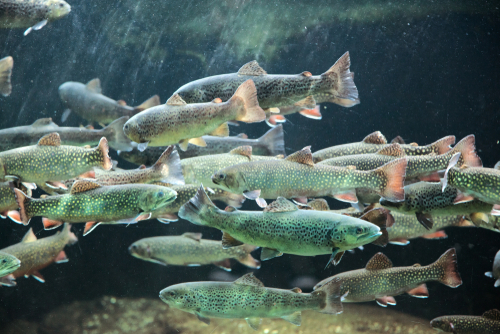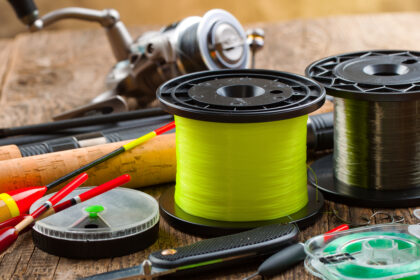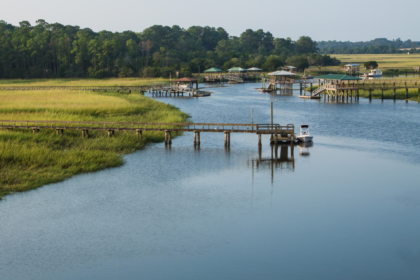It’s no secret that there is a variety of fish species in our earth’s waters, which can sometimes make it confusing to distinguish between them. For instance, many people often wonder is salmon trout?, or vice versa.
In reality, salmon are not the same species of fish as trout; however, they both exist in the same family of fish. They differ primarily in their fish genus, as well as the ways they appear, taste, and exist within the fish cooking world.
If you’ve ever wondered exactly how these two fish species differ from one another, keep reading. Below, we’ll discuss the key differences between salmon and trout and tips on how you can identify both of them. Follow along with us as we get into it!
Is Salmon Trout?
Salmon and trout are not interchangeable, though they do share some relations. This relation exists within the fish family they have in common, as well as their popularity among fishermen, cooks, and diners.
Trout are primarily freshwater fish, with the exception of a few species (such as steelhead trout) that spend some time in the ocean during their lives. On the other hand, salmon are both freshwater and coastal fish, as they often hatch in freshwater bodies and migrate to oceans before returning to spawn.
In this article, we’re going to explore the following questions to compare/contrast the two fish:
- Are salmon and trout in the same family?
- What are the similarities between salmon and trout?
- What are the differences between salmon and trout (nutritional, cooking, price)?
- How do you identify salmon and trout?
Are Salmon and Trout in the Same Family?
The reason so many people view these two fish as similar is that they are in the same fish family – the family called Salmonidae. This family of fish, which includes different kinds of salmon and trout, is characterized by ray-finned features. It consists of fish including:
- Graylings
- Lenoks
- Chars
- Taimens
The Salmonidae family of fish exists within the order of fish called the Salmoniformes order. What most of the carnivorous fish in the Salmonidae family have in common is that they tend to spawn in freshwater environments. Some of them venture to coastal waters for periods of time, but they always return to freshwater to breed and reproduce.
Furthermore, one of the “lineages” (a.k.a. “subfamilies”) within the Salmonidae family encompasses both trout and salmon. This subfamily is called the Salmoninae lineage. This commonality further groups the two together as very similar fish.
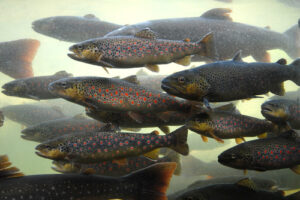
What Are the Similarities?
Aside from sharing the same family and lineage, these two fish have a few other traits and habits in common, including the following:
- Relatively long lifespan
- Great for eating/cooking
- Variety of species
- Physical structure
Lifespan
Both species are known to live up to 20 years in some cases. Although they may have much shorter lifespans, due to fishing industries and other environmental factors, they share this quality.
Great for Eating/Cooking
Both salmon and trout are popular when it comes to edible fish. People love to eat them by grilling, charring, baking, and frying them.
Although they have different costs, flavors, and nutritional values (which we’ll explain more in-depth later on), they both make a great, healthy choice for dining.
Variety of Species
Both salmon and trout also have many species. There are king, Alaskan, farm-raised, sockeye, and more. And when it comes to trout, there are steelhead, brook, rainbow, golden, and others.
Physical Structure
Because these two fish descend from the same place, evolutionarily, they share a similar physique and structure. Many salmonids share the same features, such as pelvic fins located far back on the body, a round scale design, a single row of teeth, and forked tails.

What Are the Differences?
Now that you’re aware of the similarities, let’s dive into the differences between salmon and trout. Many of these factors are in terms of how the two fish differ when you catch, buy, prepare, or eat them.
Salmon is generally considered the more high-end of the two fish, especially when they are caught in the wild. Let’s dive into why salmon receive this distinction.
Cooking Differences
Both fish can be prepared in a variety of ways, and with both, chefs need to be careful not to overcook them. Both fish should be de-boned and de-scaled prior to cooking. But when it comes to salmon, there is a lot more you can do in the kitchen than you can do with trout.
For example, salmon works well when prepared raw or cooked. This is why you’ll often see it included in raw sushi. But you won’t see trout prepared that way. It can also work well in a salmon salad, smoked for lox bagels, and other variations.
But trout is a pretty simple, subtle-tasting fish that needs to be prepared with light seasoning and cooked fully through.
Nutritional Differences
These two fish are both healthy, but salmon wins out when it comes to nutritional value. For one, salmon is far more heart-healthy, containing essential omega-3 fatty acids. And although salmon outweighs trout in terms of overall caloric content, it also has far more healthy protein and more nutrition within those calories.
You don’t have to worry about carb intake with either fish, but trout has more sodium and less Vitamin content than salmon does. If you want to choose the fish that’s better for you, go for salmon.
Price Differences
Because salmon is coveted above trout, they also differ in terms of price. Per pound, trout is usually sold for a few dollars less than salmon is. You may be able to get farm-raised salmon for comparable prices to trout, but when you do so, you’re compromising quality and flavor.
Size Differences
Finally, we want to point out the big distinction between sizes. Salmon are generally larger and heavier than trout, though trout are sometimes longer.
Some salmon have been known to exceed 100 pounds within their lifetimes, and on average weigh about 10 pounds. On the other hand, trout typically don’t ever exceed 50 pounds, and weigh on average about 8 pounds.
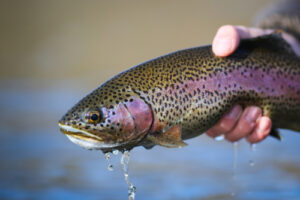
How to Identify
When you go to the market, fish are easily identifiable with name tags. But identifying salmon and trout when you’re fishing is a bit more difficult.
Salmon Identification
To identify salmon, consider the location. You’re likely to find both salmon and trout in freshwater locations, but salmon are far more likely to also be found in saltwater locations.
Further, salmon are identifiable by their internal colors – usually pink or orange due to the crustaceans they eat.
Salmon bodies tend to be longer in general, with a pointed forked tail shape.
Trout Identification
Trout often reside in freshwater locations, like mountainous areas with large lakes and rivers. If you think you’ve caught a “trout” in the ocean, it’s probably not a trout.
Colorwise, trout is often a fish with meat that is white-colored. On the outside, trout are often brown or gray in color. Some species even have spotted patterns. A more detailed guide can be found here.
Trout bodies tend to be rounder and shorter than salmon, and they have a convex forked tail shape.
Final Thoughts
So, is salmon trout? In short, salmon and trout are not the same, even though they share the same fish family and lineage. While they both occupy freshwater for spawning, only salmon venture to the ocean.
Salmon are healthier, more expensive, and easier to prepare in a variety of ways. Visually, they’re different in color and size, which is how you can tell them apart.

